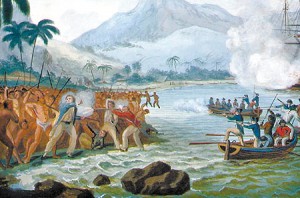 Tattooing may very well owe it’s modern popularity to the number of celebrities who have openly sported their ink. Stars like Cher, Julia Roberts, Pamela Anderson, Ben Afflek, and Johnny Depp have all had their tattoos shown to the public form one time to another. You may find it strange but this is not the first time celebrity has given a boost to the public’s outlook on the art. Our Modern royalty were not the first to lay claim to tattoos being the “in” thing to do.
Tattooing may very well owe it’s modern popularity to the number of celebrities who have openly sported their ink. Stars like Cher, Julia Roberts, Pamela Anderson, Ben Afflek, and Johnny Depp have all had their tattoos shown to the public form one time to another. You may find it strange but this is not the first time celebrity has given a boost to the public’s outlook on the art. Our Modern royalty were not the first to lay claim to tattoos being the “in” thing to do.
After Captain Cook returned from his famous voyage to Polynesia, something that many have accredited with bringing the art of tattooing back to Europe, in the 1800’s tales of the heavily tattooed natives were the talk of the town in England and France. Cook’s Science Officer and Expedition Botanist Sir Joseph Banks returned to England with a tattoo, and Cook had talked a tattooed Tahitian chief into making the voyage back to England with him.
Presenting him to King George seemed to set off a hidden tribal instinct in the monarch, for not long afterward the king had gotten himself inked with the ‘Cross of Jerusalem’ when he traveled to the Middle East in 1862. The royal blood must have caught the bug so many of us become infected with after our first tattoo because on a trip to the Orient he also had a dragon emblazoned on his forearm, from the needles of an acclaimed Japanese tattoo master.
George’s sons, The Duke of Clarence and The Duke of York, took a cue from ‘ol dad and soon were also tattooed in Japan while serving in the British Admiralty and setting the stage for what would soon become a family tradition, as well as starting a fad among the royalty. King Edward VII soon was sporting ink of his own and this was quickly followed by King Frederik IX of Denmark, the King of Romania, Czar Nicholas of Russia, and King Alexandar of Yugoslavia to name a few. Mostly elaborate family coats of arms.
The tattooing craze soon spread through out the upper crust of British society, as well as the privileged from all over Europe. Everybody who was somebody in the late 1800’s was getting inked. Sounds familiar, doesn’t it? The social elite would gather together in drawing rooms to strip and show off their ink. Even Winston Churchill’s mother had a tat, and it was long rumored that Queen Victoria, the bulwark of the uptight, had a small tattoo herself.
When the celeb’s of the day, in this case royalty, catch onto a craze you can be certain that the top dogs will soon follow suit, and to be certain that was what was occurring in Europe during the first tattoo craze to hit the western world in centuries.
Soon tattooing began to take shape as a lucrative business all over Europe. Since most tattoo artists worked out of their homes, they did most of their business in the home’s parlor. The Tattoo parlor was born, and the term has stuck with the art ever since, though some artists tend to use the more artsy term studio now.
Naturally since the rich and famous were getting inked it was only natural that the supposed “lower classes” were soon to follow suit and the craze remained in full swing for many years, until the novelty began to wear off. After that tattooing became regulated to traveling circuses, and lower portions of the social ladder, with the exception of the military. Most notably the Navy where the tradition of the tattooed sailor has continued to flourish ever since Cook rediscovered the art.
It’s all well and good to think that we are a bit more educated, and perhaps a bit more sophisticated that our counterparts were over a hundred years ago. We certainly are more health conscious, and the sterility of applying a good tattoo has never been higher. Perhaps it is this difference that will allow tattooing a continued place in modern society. Perhaps this craze will turn out to be a little bit more and tattooing will take it’s place as an accepted mode of human adornment.
We can hope.